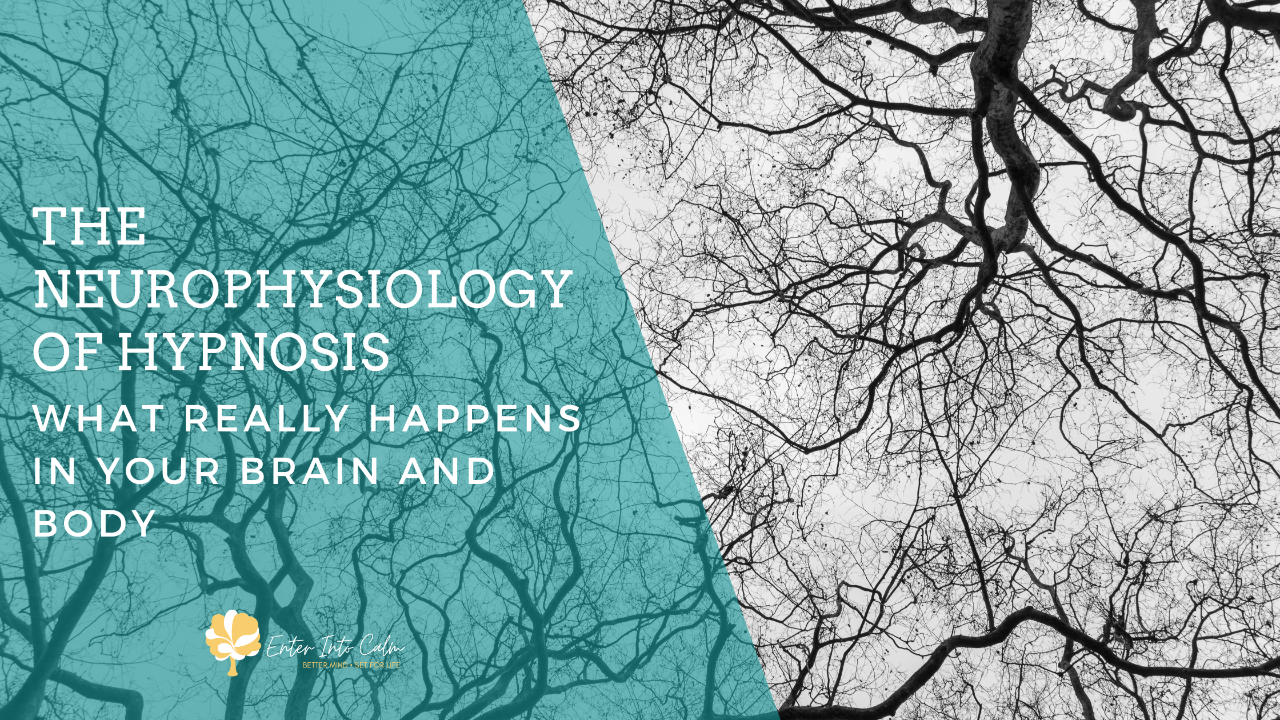The Neurophysiology of Hypnosis: What Really Happens in Your Brain and Body
Nov 01, 2025
Have you ever wondered what’s really going on in your brain when you’re in a hypnotic trance?
You’re relaxed, aware, maybe even deeply focused - but somehow, things feel different. Words sink in more easily. You imagine something, and your body responds. You leave the session feeling lighter, clearer, or changed in ways that feel effortless.
That’s not magic - it’s physiology. Every thought, emotion, and image you experience creates measurable activity in your brain and body. When we understand what’s happening behind the scenes, hypnosis becomes even more fascinating - and far more credible as a tool for healing and personal growth.
How Hypnotic Suggestion Works
Let’s start with a quick brain refresher. Each of your thoughts or sensations travels along a vast network of nerve cells - neurons. These neurons communicate across tiny gaps called synapses using chemical messengers. When you repeat a thought, feeling, or behavior, those neural connections strengthen - like walking the same path through tall grass until it becomes a well-worn trail.
That strengthening process is called neurological potentiation (or kindling). It’s how we learn, remember, and build habits.
In hypnosis, we use suggestion and focused attention to strengthen new neural pathways — the ones that lead toward calm, confidence, or healing — while gently letting the old, unhelpful ones fade.
Think of it as teaching your brain a new route to peace.
Habits: Your Brain’s Shortcuts
Habits are your brain’s way of saving energy. You don’t have to think about how to brush your teeth or drive to work - your brain has built-in shortcuts to handle those tasks automatically.

The same thing happens with emotional habits. Maybe stress triggers overeating, or anxiety brings on racing thoughts. These patterns feel automatic because they’re wired into well-traveled neural paths.
Through hypnosis, you can change those patterns. By combining relaxation, imagery, and suggestion, hypnosis helps you rewire those automatic responses - dissolving the ones that no longer serve you and strengthening new ones that do.
The Science of Kindling
Here’s where it gets exciting. Each neuron in your brain can connect to about 5,000 others - creating a web so complex that even supercomputers can’t replicate it.
Recent research (Gidon, 2020) found that neurons communicate not just through simple “on/off” signals but through a rich blend of both–and patterns. This flexibility helps explain why hypnosis can lead to creative insights, emotional release, and quick learning.
During trance, your brain becomes more adaptive - a state neuroscientists call heightened neuroplasticity. In simple terms: your mind becomes more open to change.
What Happens in the Brain During Trance
When you enter a hypnotic state, your brain shifts gears. Subtle changes happen in several key areas:
|
Brain Area |
What It Does During Trance |
|---|---|
|
Hippocampal Cortex |
Supports memory, imagination, and emotional learning — becomes highly active. |
|
Corpus Callosum |
Strengthens communication between the right and left hemispheres — logic and creativity start working together. |
|
R-Complex (Reptilian Brain) |
Calms down habitual stress and survival reactions. |
|
Optic Chiasm |
Helps integrate visual and sensory imagery, enhancing focus and imagination. |
As signals move through these regions, neurochemicals flood the brain, balancing activity between both hemispheres. This creates a whole-brain state — calm, focused, and flexible — what we call trance.
In this state, time may feel distorted (“Wait, it’s been 30 minutes already?”) or details might blur (“I don’t remember every word, but I feel different”). That’s not forgetfulness — it’s a sign your mind was deeply engaged in re-patterning itself.
Rewiring for Change
During hypnosis, neurons temporarily lower their electrical resistance, making it easier to form new connections. With well-crafted suggestions and imagery, your brain begins to “install” new pathways — ones aligned with healing, growth, and peace.
This same process happens naturally in moments of deep emotion or insight — which is why hypnosis can help people shift patterns that have felt stuck for years.
Mind–Body Connections
The brain doesn’t work in isolation. Every mental event sends ripples through the body. Imagine biting into a lemon — even the thought makes your mouth water. That’s your mind and body communicating instantly.
The brain and endocrine system release nearly 200 hormones and neurotransmitters that affect mood, immune function, and even pain perception. Hypnosis helps you influence those systems consciously — calming stress hormones, activating healing responses, and promoting balance.
Some scientists see this as purely biological. Others believe the brain acts like a receiver for a broader field of consciousness — tuning in to healing and insight that extend beyond the physical. Whichever perspective you hold, hypnosis bridges both worlds beautifully.
The Power of Trance

When you enter trance, something extraordinary happens:
- Both hemispheres of your brain synchronize.
- Neural pathways become more fluid and receptive to positive suggestions.
- The mind becomes focused yet open — the perfect state for learning and healing.
- Through guided imagery and language, you begin to reshape habits, beliefs, and emotional responses.
It’s not “mind control.” It’s mind collaboration — your conscious and subconscious working together for your highest good.
Hypnosis reminds us that healing isn’t something done to you — it’s something awakened within you.
Moving Forward
At The Calm Collective Care, we are committed to making these life-changing benefits accessible to everyone. Thanks to the flexibility of Zoom sessions, you can now experience the power of hypnosis from the comfort of your home. Whether you are seeking help with a chronic condition or for another reason, our holistic approach—blending hypnosis, coaching, and mindfulness techniques—can help you unlock your body’s natural healing potential.
If you are ready to experience the transformative power of hypnosis, we invite you to connect with us today. Let’s work together to unlock your body’s natural healing abilities and help you live life to its fullest.
Incorporating hypnosis into your daily routine can be simple and incredibly rewarding. Here are some practical ways to get started:
- Guided Hypnosis Sessions: At Calm Collective Care, we offer guided hypnosis sessions every Friday at 11:30 AM PST. These sessions are designed to help with confidence building, stress reduction, and more. If you cannot attend the live session but have signed up, you will still receive access to the recording, allowing you to benefit from the session at your convenience. To participate, simply sign up here and join us for a live session or listen to the recording at a time that works best for you.
- One-on-One Hypnosis: For a more personalized approach, consulting with a certified hypnotist can offer tailored strategies that align with your specific goals and challenges. At the Calm Collective Care we have a variety of practitioners ready to chat about hypnosis and how it might help your individual situation. We offer a free 15-minute consultation to go over any questions you may have. [Link to 15-minute phone call]
To experience hypnosis firsthand, check out the Calm Collective Care and take advantage of our free Friday sessions. Link to sign up for Friday session.
Additionally, you can browse our team of practitioners and schedule a call.
Guest Author:
Hannah Henjum
Consulting Hypnotist, NLP & Time-Line Therapy® Practitioner
Specialties: Stress | Confidence
Hannah specializes in helping clients overcome stress and build confidence and joy in their daily lives. She uses hypnosis and NLP techniques to help individuals resolve the underlying mental and emotional blocks that affect their well-being and self-esteem. Her approach is centered on creating a balanced, fulfilling life for her clients, helping them develop strategies for long-term mental clarity and resilience. Hannah empowers clients to bring curiosity, joyfulness, and ease back to their lives.
References:
-
Gidon, A. (2020). Dendritic Action Potential and Computation in Human Layer 2/3 Cortical Neurons. Science, 367(6473), 83–87.
-
Benson, H. (1984). Beyond the Relaxation Response.
-
Spiegel, H. & Spiegel, D. (2004). Trance and Treatment.
-
Kroger, W. S. (2008). Clinical and Experimental Hypnosis (2nd ed.).
-
Rossi, E. (1993). The Psychobiology of Mind/Body Healing.
-
Dossey, L. (1993). Healing Words
Be Calm ...
and experience hypnosis!
Hypnosis can help in many ways. Curious Minds should Stay Curious.
Boost Self-confidence • Lessen Anxiety • Grief• Cancer • Create Positive Mindset • Eliminate Limiting Beliefs • Improve Sleep • Manage Pain Better • Prepare for Childbirth • Enhance Performance • Heal & Resolve Grief • Change Habits • Weight Loss without Dieting • Smoking Cessation • Stress Reduction • Stop Teeth Grinding • & more
Connecting with me 1:1 is fast and easy!


